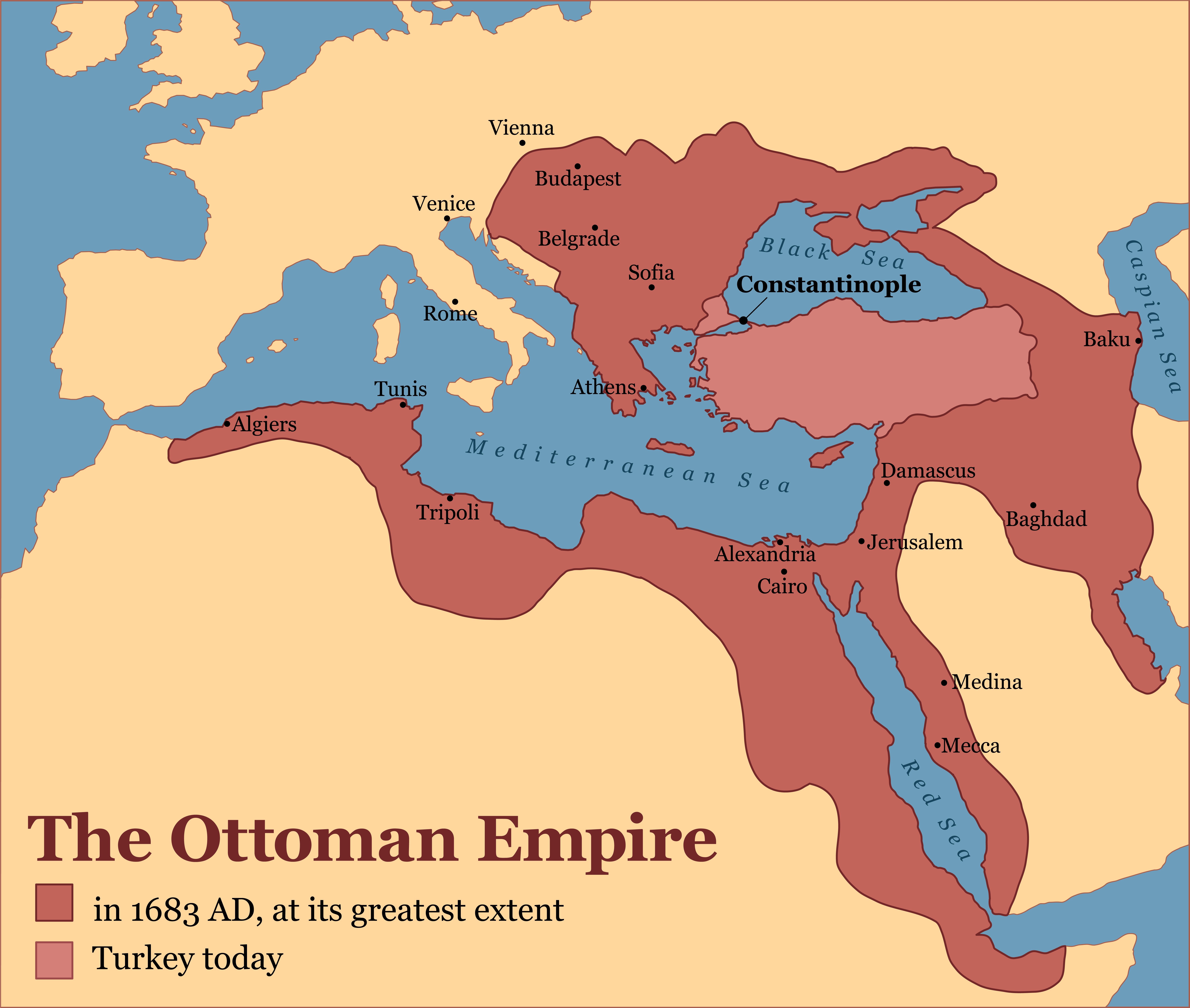On the 100th anniversary of its end on November 1 1922, we look at five things you need to know about it.
1. What was its size and how long did it last?
The Ottoman empire lasted almost 600 years, from the early 1300s until the aftermath of the first world war. The word Ottoman derives from the Arabic version of Osman – the name of its first ruler. The empire had a humble beginning as a provincial principality in Anatolia (now part of Turkey).
What transformed it into a rising and sizeable force in world politics was the gradual expansion into the lands of the declining Byzantine empire. This process came to a conclusion in 1453 with the conquest of Constantinople, the capital of the Byzantine empire.
Constantinople was renamed Istanbul and it became the seat of a new rising empire. In the 15th century the city became a vibrant centre of trade and architectural innovation. A period of steady expansion followed and the empire extended over parts of the Middle East along the Red Sea, northern Africa, the Balkans and eastern Europe and up to the walls of the city of Vienna.
2. How much power did it have?
The height of the empire’s power came in the 16th century with the rule of Süleyman the Magnificent, one of the empire’s longest-running sultans . A testament to the power of the empire is the fact that Süleyman acquired the nickname “magnificent” in the west. Within the Ottoman empire he was known as “the lawgiver”.
During his reign, the empire acquired a new legal code and underwent a period of cultural renaissance powered by a blend of Christian, Islamist and Arabic elements. The empire also offered safe passage to Sephardic Jews fleeing persecution in the Iberian Peninsula (Spain and Portugal).
By the early 16th century, the Ottoman empire had one of the largest Jewish communities in the word. Constantinople, the city wasn’t officially renamed Istanbul until 1930, became a real blend of cultures. And throughout the renaissance, the Ottomans became the biggest trade partner of western Europe.
3. What was its effect and relationship with Europe?
The walls of the city of Vienna marked the apex of the Ottoman’s empire power and the beginnings of its slow and gradual demise. The empire became a subject of admiration in the European courts. Its cultural life attracted the attention of western European thinkers and artists. Its military organisation and might captured the attention of theorists and politicians alike. The Ottomans became one of the key subjects of the 18th and 19th century aesthetic and scientific movement known as Orientalism.
Crucially, the Ottoman Empire was in part a European empire. Its reach extended over lands such as the Balkans and southeastern Europe that now firmly belong in Europe. And, despite its diminishing power in the 18th and 19th century, Christian and Muslim populations across the Balkans and the eastern Mediterranean lived alongside one another in relatively tolerant societies.
This begins to change from the middle of the 19th century due the empire’s centralisation of power and administration, away from its diverse and far-flung parts. By the early 20th century, the European provinces of the empire become sites of violence and ethnoreligious conflict. The turning point is the Balkan wars (1912-3) which cut off from the empire some of its most diverse and richest provinces in southeastern Europe.
A map of the Ottoman Empire in 1683, and Turkey today. Image credit: Peter Hermes Furian/Shutterstock.com
4. What was its relationship with the Arab world?
The Ottoman empire extended its reach across parts of what is now known as the Arab world from Cairo to Algiers. For a long time, the Ottoman grip in the Middle East was minimal. The key preoccupations were with the protection of key trade outposts and the holy cities of Islam. Having mutual trade links and economies led different regions to exist happily as one unit, and retain loyalty to the Ottoman empire.
With the outbreak of the first world war, however, this started to change. The rise of Arab nationalism and the dynamics of the war propaganda fomented movements across the Arab world that actively sought to break with the Ottoman state.
5. What is its influence on modern Turkey?
The defeat of the Greek army in Anatolia in 1922 by the forces of Turkish nationalism marked the de facto collapse of the Ottoman empire and the emergence of a new successor state, modern Turkey. The Greek-Turkish war became a rallying cry for anti-colonial pan-Islamist movements across the Middle East and India.
But Mustafa Kemal Ataturk, Turkey’s founder and first leader, wanted to make a radical break from the Ottoman heritage. He moved the capital of the new state from Constantinople to Ankara and initiated a series of rapid reforms such as the change of the alphabet and the abolition of the khalifate, the idea of an absolute monarchy over the Islamic world. Despite the radical break with the imperial past, a debate between tradition and modernisation continued to shape the evolution of Turkish political life.
In the past few decades Turkey has been witnessing the return of a political and cultural movement that pushes back against the western, secular orientation of the country and looks back selectively at the Ottoman past as a guide for the present. The decision by Erdogan’s government to convert the famous Byzantine temple Hagia Sophia back into a mosque in 2020, despite widespread international condemnation, offers a tangible example of a nod to the Ottoman past in modern Turkey.
Georgios Giannakopoulos, Visiting Research Fellow, King’s College London/ Lecturer in Modern History, City University of London, King’s College London
This article is republished from The Conversation under a Creative Commons license. Read the original article.
Source Link: Five Things You Need To Know About The Ottoman Empire
